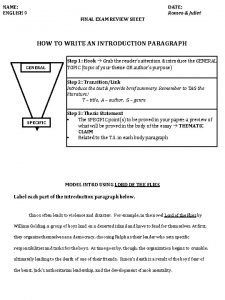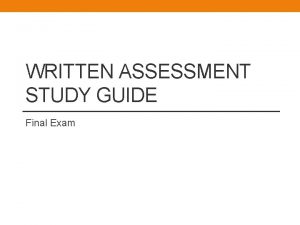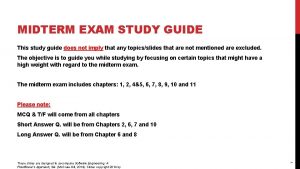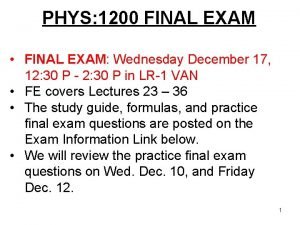2 nd Quarter Final Exam Study Guide Final

















- Slides: 17

2 nd Quarter Final Exam Study Guide

Final Exam Wednesday, Dec 18 Thursday, Dec 19 7: 40 – 8: 35 Period 1 Advisory 55 min 7: 40 – 7: 57 Period 1 Advisory 17 min 8: 39 – 9: 59 Period 7 Final 80 min 8: 01 – 9: 21 Period 4 Final 80 min 10: 03 – 11: 23 Period 2 Final 80 min 9: 25 – 10: 45 Period 5 Final 80 min 11: 27 – 12: 47 Period 3 Final 80 min 10: 49 – 12: 09 Period 6 Final 80 min 12: 47 – 1: 17 Lunch 30 min 12: 09 – 12: 39 Lunch 30 min 1: 23 – 1: 39 Period 8 Advisory 16 min

Final Exam • Exam will be in four parts, 20 questions each (80 total, all multiple choice) – – Part 1: The Atmosphere Part 2: Weather Factors Part 3: Weather Patterns Part 4: Stars & Galaxies • Questions will be similar to, but not the same, as your quizzes • Each part counts as a quiz retake, but will not lower your grade

The Atmosphere • Study all assignments & notes • Composition of the atmosphere – What is the most abundant gas in out atmosphere? What is the 2 nd most abundant gas? – Know other important trace gases in our atmosphere (CO 2, O 3, H 2 O) – Know about particles in atmosphere, why are they important (2 main reasons) • How does the atmosphere allow for life on planet Earth?

The Atmosphere • Know the three major properties of air – Mass, density, pressure • What is air pressure? – How is air pressure measured in weather reports? (inches of mercury, in Hg) – How is air pressure measured on weather maps? (millibars, 1000 bars, mb) • What type of instrument measures air pressure? • What does altitude mean? – What happens to air density with increased altitude? – What happens to air pressure with increased altitude?

The Atmosphere • Know the four major layers of the atmosphere, and what order they are in – What makes each layer different (temperature, density, pressure) • Troposphere (where we live) – Turbulent, chaotic, always changing layer. Where does most weather occur? – Which layer is lowest in altitude? Which layer has the highest air density and air pressure? • Stratosphere – Calm layer with little weather – Do we travel in the stratosphere? (jet planes, weather balloons) – Ozone Layer absorbs ultraviolet radiation (UV)

The Atmosphere • Mesosphere – Most meteors and falling satellites burn up in this layer from heat caused by air friction • Thermosphere – Layer with highest altitude – Ionosphere: lower part, charged gas particles interact with charged solar particles to form auroras – Exosphere: higher part, blends into space gradually, no clearly defined boundary

The Atmosphere • What are pollutants? (harmful gases or particles in the air, water, or soil) • What are two major sources of pollution? (nature and human activities) • What is smog? • What is acid rain?

Weather Factors • Know the three type of heat (energy) transfer • Where does our atmosphere get its energy from to drive the weather? • What type of heat transfer gets energy from the Sun to Earth’s atmosphere? – How does it travel through space? • Know about electromagnetic waves and the electromagnetic spectrum – What types of energy are part of the EM spectrum? – What is visible radiation? – What two types of non-visible radiation affect us every day?

Weather Factors • What happens to the Sun’s energy as it enters Earth’s atmosphere? – Some is reflected back into space – Some is absorbed by the atmosphere – Some is absorbed by Earth’s surface, and then radiated back into atmosphere at night • What is the greenhouse effect?

Weather Factors • What is wind? How does differences in air pressure affect the wind? • What instrument do we use to measure the wind? • What is the wind chill factor? • Explain local winds using the examples of land breezes and sea/lake breezes

Weather Factors • Understand the global convection currents that affect global winds – Calm areas: doldrums, horse latitudes – Wind belts: trades, westerlies, easterlies • Understand the Coriolis Effect • What is the jet stream?

Weather Factors • Understand the water cycle. How does water move between the atmosphere and Earth’s surface? • What is evaporation? What is condensation? • What is humidity? What is relative humidity? – What instrument do we use to measure humidity? • How do clouds form? (involves cooling and particles) – What is the dew point?

Weather Factors • How do we classify clouds? – Shape: cirrus, cumulus, stratus – Altitude: low, middle, high – Fog • What is precipitation? Name major types of precipitation.

Weather Patterns • Know the five major types of air masses – – – Maritime tropical Maritime polar Continental tropical Continental polar Continental arctic • Why do most air masses in the US move to the East, but hurricanes move to the West?

Weather Patterns • Know what a front is, and the four major types – Cold front, warm front, stationary front, occluded front – What type of weather do cold fronts often bring? • What are highs (H) and lows (L) on weather maps? How do highs and lows relate to cyclones? • What is the difference between a cyclone and a cyclonic storm?

Weather Patterns • What is a thunderstorm? How is it different from other rain cloud systems? • What is a tornado? Where do tornados form? Understand tornado safety • Why do so many tornados form in Tornado Alley? (has to do with moving air masses) • What is a hurricane? Where do hurricanes form, and where do they move?
 World history and geography final exam study guide
World history and geography final exam study guide American history final exam
American history final exam Physical science jeopardy
Physical science jeopardy Romeo and juliet exam review
Romeo and juliet exam review Final exam environmental science
Final exam environmental science Civics and economics final exam study guide
Civics and economics final exam study guide Ap world history final exam
Ap world history final exam Physics semester 1 final exam study guide answers
Physics semester 1 final exam study guide answers World history 1st semester final review answers
World history 1st semester final review answers Zoology final exam
Zoology final exam Pols 1101 final exam
Pols 1101 final exam World history fall final review answers
World history fall final review answers 1 quarter time
1 quarter time Clock showing quarter past 7
Clock showing quarter past 7 You should study hard.
You should study hard. Nc state bar paralegal search
Nc state bar paralegal search Nocti computer programming
Nocti computer programming Biology 1st semester study guide
Biology 1st semester study guide

































